What is Downy Mildew?
Downy Mildew is a disease caused by a fungus like organism called an Oomycete. The disease thrives in high humidity and can infect plants very quickly, sometimes in a matter of hours.
Symptoms & Occurrence:
Downy Mildew most commonly occurs in summer and autumn, especially if conditions are wet. The optimum temperature for this disease is between 15oC and 21oC.
The main symptoms of Downy Mildew are light green areas on the top of leaves and white sporulation (white, furry fungal growth) underneath the leaves. Both of these symptoms will spread across the whole leaf and eventually the leaf will yellow and fall off.
Control:
For plants that are undercover, we recommend allowing good air flow throughout the plants. Keeping greenhouses and polytunnels at an even temperature will also help. We also advise against watering unnecessarily and from midday onwards (particularly in the evening) as this will result in water being sat on the leaves for long periods of time. As this disease is easily spread, ensure that all tools, trays and pots are thoroughly cleaned in between handling plants. Remove any weeds as and when you see them and keep areas clear of old leaves.
We recommend using a versatile fungicide designed to target root rot and downy mildew, for example Promess. A broad spectrum fungicide such as Amistar will also control downy mildew.
For more information on controlling downy mildew, please get in touch with our sales team on 01522 246491.









